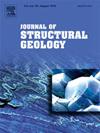Strain rates recorded in the perimeter-area relationship of recrystallized quartz aggregates from the Sandhill Corner shear zone, Maine, USA
IF 2.6
2区 地球科学
Q2 GEOSCIENCES, MULTIDISCIPLINARY
引用次数: 0
Abstract
Current available methods for determining strain rates during viscous deformation are limited, generally relying on the preservation of appropriate microstructures. A lesser-known method to determine strain rates of monomineralic quartz aggregates relates the perimeter-area fractal dimension (D-value) of grain boundaries to deformation conditions. We explore this method by applying it to the Sandhill Corner shear zone (SCSZ), a seismogenic shear zone exhumed from the base of the frictional-to-viscous transition. Strain-rate patterns from D-values are similar to those from flow laws combined with grain size piezometry and predict comparable magnitudes to rates from flow laws using the theoretical piezometer of Shimizu (2012). We compare quartz D-values with proxies for grain shape and grain boundary roughness and find a clear correlation between D-value and grain size, suggesting it may record flow stress. We interpret the disparity in spatial trends between D-value and recrystallized grain size within the inner shear zone as reflecting the influence of transient deformation events associated with the seismic cycle. While the D-value is commonly referred to as a measure of the degree of serration or roughness of grain boundaries, this study suggests a more complex interrelationship of the D-value, grain size, aspect ratio, and roundness. Future field work and experimental calibrations are encouraged to test our findings and refine strain-rate estimates derived from D-values.
求助全文
约1分钟内获得全文
求助全文
来源期刊

Journal of Structural Geology
地学-地球科学综合
CiteScore
6.00
自引率
19.40%
发文量
192
审稿时长
15.7 weeks
期刊介绍:
The Journal of Structural Geology publishes process-oriented investigations about structural geology using appropriate combinations of analog and digital field data, seismic reflection data, satellite-derived data, geometric analysis, kinematic analysis, laboratory experiments, computer visualizations, and analogue or numerical modelling on all scales. Contributions are encouraged to draw perspectives from rheology, rock mechanics, geophysics,metamorphism, sedimentology, petroleum geology, economic geology, geodynamics, planetary geology, tectonics and neotectonics to provide a more powerful understanding of deformation processes and systems. Given the visual nature of the discipline, supplementary materials that portray the data and analysis in 3-D or quasi 3-D manners, including the use of videos, and/or graphical abstracts can significantly strengthen the impact of contributions.
 求助内容:
求助内容: 应助结果提醒方式:
应助结果提醒方式:


